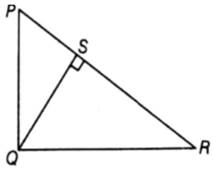In given figure, PQR is a right triangle, right angled at Q and QS ⊥ PR. If PQ = 6 cm and PS = 4 cm, then find QS, RS and QR.

Given,
∆PQR in which ∠Q = 90°,
QS ⊥ PR and PQ = 6cm.
PS = 4cm
In ∆SQP and ∆SRQ,
∠PSQ = ∠RSQ [each equal to 90°]
∠SPQ = ∠SQR [each equal to 90°-∠R]
∴ ∆SQP ∼ ∆SRQ
Then,
= SQ/PS = SR/SQ
⇒ SQ2 = PSXSR …..(i)
In right angled ∆PSQ,
PQ2 = PS2 + QS2 [by Pythagoras theorem]
= (6)2 = (4)2 + QS2
= 36 = 16 + QS2
= QS2 = 36-16 = 20
∴ QS = √20 = 2√5 cm
On putting the value of QS in Eq. (i),
we get,

In right angled ∆QSR,
QR2 = QS2 + SR2
= QR2 = (2√5)2 + (5)2
= QR2 = 20 + 25
∴ QR = √45 = 3√5cm
Hence,
QS = 2√5 cm, RS = 5 cm and QR = 3√5 cm.
10